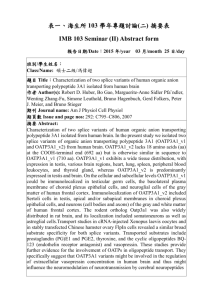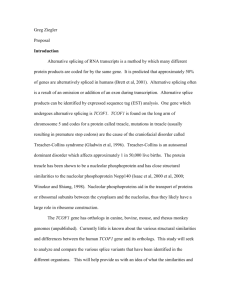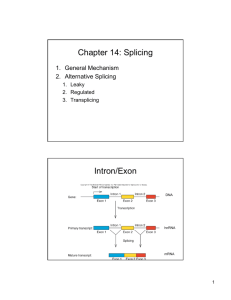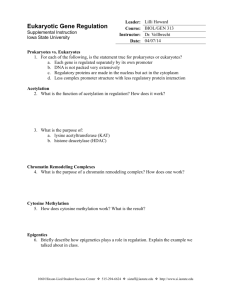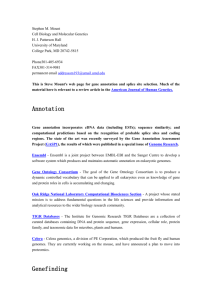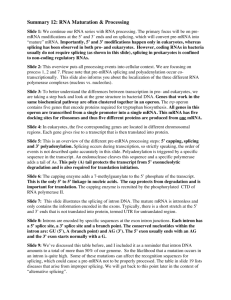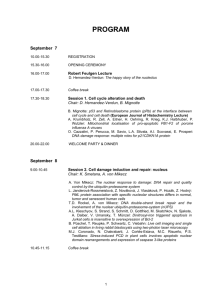splice variants in apoptotic pathway
advertisement
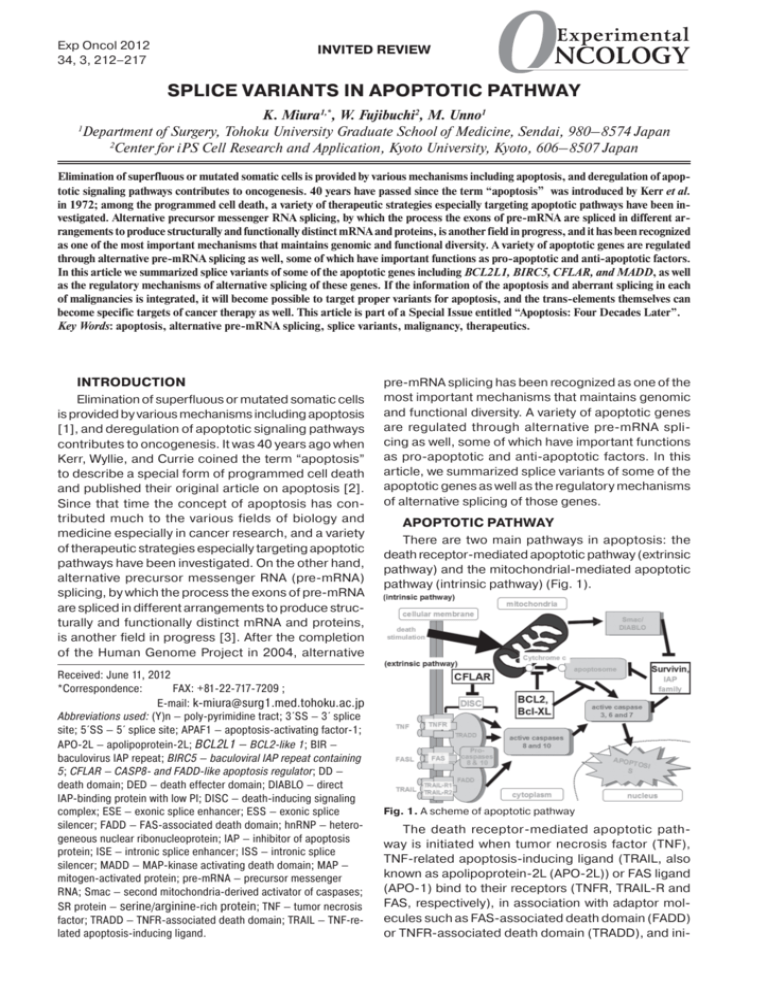
212 Exp Oncol 2012 34, 3, 212–217 Experimental Oncology 34, 212–217, 2012 (September) INVITED REVIEW SPLICE VARIANTS IN APOPTOTIC PATHWAY K. Miura1,*, W. Fujibuchi2, M. Unno1 Department of Surgery, Tohoku University Graduate School of Medicine, Sendai, 980–8574 Japan 2 Center for iPS Cell Research and Application, Kyoto University, Kyoto, 606–8507 Japan 1 Elimination of superfluous or mutated somatic cells is provided by various mechanisms including apoptosis, and deregulation of apoptotic signaling pathways contributes to oncogenesis. 40 years have passed since the term “apoptosis” was introduced by Kerr et al. in 1972; among the programmed cell death, a variety of therapeutic strategies especially targeting apoptotic pathways have been investigated. Alternative precursor messenger RNA splicing, by which the process the exons of pre-mRNA are spliced in different arrangements to produce structurally and functionally distinct mRNA and proteins, is another field in progress, and it has been recognized as one of the most important mechanisms that maintains genomic and functional diversity. A variety of apoptotic genes are regulated through alternative pre-mRNA splicing as well, some of which have important functions as pro-apoptotic and anti-apoptotic factors. In this article we summarized splice variants of some of the apoptotic genes including BCL2L1, BIRC5, CFLAR, and MADD, as well as the regulatory mechanisms of alternative splicing of these genes. If the information of the apoptosis and aberrant splicing in each of malignancies is integrated, it will become possible to target proper variants for apoptosis, and the trans-elements themselves can become specific targets of cancer therapy as well. This article is part of a Special Issue entitled “Apoptosis: Four Decades Later”. Key Words: apoptosis, alternative pre-mRNA splicing, splice variants, malignancy, therapeutics. INTRODUCTION Elimination of superfluous or mutated somatic cells is provided by various mechanisms including apoptosis [1], and deregulation of apoptotic signaling pathways contributes to oncogenesis. It was 40 years ago when Kerr, Wyllie, and Currie coined the term “apoptosis” to describe a special form of programmed cell death and published their original article on apoptosis [2]. Since that time the concept of apoptosis has contributed much to the various fields of biology and medicine especially in cancer research, and a variety of therapeutic strategies especially targeting apoptotic pathways have been investigated. On the other hand, alternative precursor messenger RNA (pre-mRNA) splicing, by which the process the exons of pre-mRNA are spliced in different arrangements to produce structurally and functionally distinct mRNA and proteins, is another field in progress [3]. After the completion of the Human Genome Project in 2004, alternative Received: June 11, 2012 *Correspondence: FAX: +81-22-717-7209 ; E-mail: k-miura@surg1.med.tohoku.ac.jp Abbreviations used: (Y)n — poly-pyrimidine tract; 3´SS — 3´ splice site; 5´SS — 5´ splice site; APAF1 — apoptosis-activating factor-1; APO-2L — apolipoprotein-2L; BCL2L1 — BCL2-like 1; BIR — baculovirus IAP repeat; BIRC5 — baculoviral IAP repeat containing 5; CFLAR — CASP8- and FADD-like apoptosis regulator; DD — death domain; DED — death effecter domain; DIABLO — direct IAP-binding protein with low PI; DISC — death-inducing signaling complex; ESE — exonic splice enhancer; ESS — exonic splice silencer; FADD — FAS-associated death domain; hnRNP — heterogeneous nuclear ribonucleoprotein; IAP — inhibitor of apoptosis protein; ISE — intronic splice enhancer; ISS — intronic splice silencer; MADD — MAP-kinase activating death domain; MAP — mitogen-activated protein; pre-mRNA — precursor messenger RNA; Smac — second mitochondria-derived activator of caspases; SR protein — serine/arginine-rich protein; TNF — tumor necrosis factor; TRADD — TNFR-associated death domain; TRAIL — TNF-related apoptosis-inducing ligand. pre-mRNA splicing has been recognized as one of the most important mechanisms that maintains genomic and functional diversity. A variety of apoptotic genes are regulated through alternative pre-mRNA splicing as well, some of which have important functions as pro-apoptotic and anti-apoptotic factors. In this article, we summarized splice variants of some of the apoptotic genes as well as the regulatory mechanisms of alternative splicing of those genes. APOPTOTIC PATHWAY There are two main pathways in apoptosis: the death receptor-mediated apoptotic pathway (extrinsic pathway) and the mitochondrial-mediated apoptotic pathway (intrinsic pathway) (Fig. 1). Fig. 1. A scheme of apoptotic pathway The death receptor-mediated apoptotic pathway is initiated when tumor necrosis factor (TNF), TNF-related apoptosis-inducing ligand (TRAIL, also known as apolipoprotein-2L (APO-2L)) or FAS ligand (APO-1) bind to their receptors (TNFR, TRAIL-R and FAS, respectively), in association with adaptor molecules such as FAS-associated death domain (FADD) or TNFR-associated death domain (TRADD), and ini- Experimental Oncology 34, 212–217, 2012 (September) tiator caspases-8 and -10 are cleaved and activated, thus resulting in the activation of executor caspases-3, -6 and -7 and culminating in apoptosis. On the other hand, the mitochondrial-mediated apoptotic pathway is initiated when pro-apoptotic proteins release free cytosolic cytochrome c. Once released, cytochrome c promotes the assembly of a caspase-activating complex termed the apoptosome, which includes apoptosis-activating factor-1 (APAF1), dATP, and pro-caspase-9. The apoptosome activity functionally corresponds to the activity of caspase-9, and it activates executor caspases-3, -6, and -7, thus inducing apoptosis. The inhibitor of apoptosis protein (IAP) proteins such as cIAP1, cIAP2, and XIAP can prevent the proteolytic processing of pro-caspases-3, -6, and -7 by blocking the cytochrome c-induced activation of pro-caspase-9 in the intrinsic pathway; in contrast, these IAP proteins do not act in the extrinsic pathway [4]. APAF1/cytochrome c-independent and second mitochondria-derived activator of caspases (Smac)/ direct IAP-binding protein with low PI (DIABLO)-dependent induction of apoptosis have also been reported. Alternative models of programmed cell death have been proposed, but still remain to be further clarified, including autophagy, paraptosis, mitotic catastrophe, and the descriptive model of apoptosis-like and necrosis-like programmed cell death [1, 5]. ALTERNATIVE PRE-mRNA SPLICING Pre-mRNA splicing is a mechanism that removes introns from pre-mRNA and binds exons, eventually generating mature mRNA (Fig. 2). The process of pre-mRNA splicing is regulated by two elements: cis-elements and trans-elements, and the cis-elements are bound by the trans-elements in pre-mRNA splicing. Among the cis-elements, consensus splice sites are essential for pre-mRNA splicing and are comprised of a 5´splice site (5´SS), a branch point motif, a poly-pyrimidine tract ((Y)n), and a 3´splice site (3´SS) (Fig. 3). Among the consensus splice sites, the 5´SS is also known as a splice donor site and the 3´SS is also known as a splice acceptor site. Splice enhancers and silencers are known as cis-regulatory elements, and both of these sites are important for the recognition of the 5´SS and 3´SS regions, and depending on their localization within the genome, splice enhancers and silencers are subclassified into exonic splice enhancers (ESEs), intronic splice enhancers (ISEs), exonic splice silencers (ESSs) or intronic splice silencers (ISSs). Among the known trans-elements, spliceosomes are multicomponent complexes essential for pre-mRNA splicing. ESEs are predominantly bound and recognized by members of serine/arginine-rich proteins (SR proteins, symbolized by SRp) and SR-like proteins. However, heterogeneous nuclear ribonucleoproteins (hnRNPs) commonly bind to ESSs and ISSs. In many cases, hnRNPs block spliceosome assembly, thus resulting in exon skipping. Several of tissue-specific SR proteins and hnRNPs have recently been identified. Aberrant 213 alternative pre-mRNA splicing in malignancies can be subclassified into two categories: (I) the generation of an aberrant splice variant as an individual transcript and (II) an aberrant expression profile of splice variants as an entire set of transcripts in malignant cells (Fig. 3). Fig. 2. Alternative pre-mRNA splicing. Seven types of alternative splicing were indicated Fig. 3. Regulatory mechanism of alternative pre-mRNA splicing and its alteration in malignancies. Cis-elements are indicated with rectangles and trans-elements are indicated with ellipses. In the nucleotide sequences, Y denotes a pyrimidine (U or C) and R denotes a purine (G or A). ESE, exonic splice enhancer; ESS, exonic splice silencer; hnRNP, heterogeneous nuclear ribonucleoprotein; ISE, intronic splice enhancer; ISS, intronic splice silencer; snRNP, small nuclear ribonucleoprotein; SR, serine/ arginine-rich protein; SS, splice site; U2AF, U2 small nuclear ribonucleoprotein auxiliary factor SPLICE VARIANTS IN APOPTOTIC PATHWAY Expression profiles of genes in the apoptotic pathway can also be regulated by alternative pre-mRNA splicing in both normal and malignant tissues, and some of those, BCL2L1, BIRC5, CFLAR, and MADD, will be highlighted in this session (Fig. 4). BCL2-like 1 (BCL2L1) Apoptotic factors of the BCL2 family are classified into two subgroups: anti-apoptotic (e.g., BCL2, MCL1, and Bcl-xL) and pro-apoptotic (e.g., BAX and Bcl-xS) [6], and the two subgroups differ in the number and variety of BH domains they contain [7]. In 1993 Boise et al. isolated BCL2-like 1 (BCL2L1) gene which functions as a BCL2-independent regulator of apoptosis (Fig. 1) [8], and alternative splicing resulted in two distinct BCL2L1 mRNA isoforms: the larger variant (Bcl-xL) which is similar in size and predicted structure to BCL2 and the smaller variant (Bcl-xS) which inhibits the ability of BCL2 to enhance the survival (Fig. 4 a). 214 Fig. 4. Splice variants of genes in the apoptotic pathway. (a) BCL2L1, (b) BIRC5, (c) CFLAR, and (d) MADD. For each of the genes, pre-mRNA is indicated at the top, and mature mRNAs are indicated in the bottom. ID numbers of mRNAs and the numbers of amino acids were referred to the NCBI database (as of June 1, 2012) The overexpression of Bcl-xL confers resistance to apoptosis (see Fig. 1); in contrast, Bcl-xS can induce apoptosis and alleviate multidrug resistance; hence the regulation of alternative splicing of the BCL2L1 gene has been intensely explored since the 2000s [6, 9–21]. hnRNP F/H was reported to modulate the alternative splicing of BCL2L1 gene [9], and SC35, a member of the SR proteins family, is required to switch the alternative splicing profile of various apoptotic genes such as CFLAR, CASP8, CASP9, and BCL2L1, towards the expression of pro-apoptotic splice variants [12]. Treatments with a chemical compound emetine dihydrochloride (CAS number: 316-42-7) down-regulated the level of Bcl-xL mRNA [11]. In 2012 Michelle et al. at Universite de Sherbrooke (Quebec, Canada) [6] identified four cis-elements in exon 2 of the BCL2L1 gene which contribute to the splicing control: B2, B3, B1, and SB1 regions. Baculoviral IAP repeat containing 5 (BIRC5, survivin) In the process of apoptosis, the IAP family prevents apoptosis through direct caspase and pro-caspase inhibition (Fig. 1). The IAP family members are defined by the presence of a baculovirus IAP repeat (BIR) domain [22, 23]; currently seven genes have been isolated in this family: XIAP, cIAP1, cIAP2, ILP2, BRUCE, BIRC5 (survivin) and livin. The IAP proteins Experimental Oncology 34, 212–217, 2012 (September) are abnormally regulated and expressed in the majority of human malignancies at elevated levels, and an increasing amount of evidence has been recently accumulated regarding the effects of survivin on the anti-apoptotic pathway; hence survivin has been investigated as a therapeutic target for malignancies. Several of splice variants of survivin have been reported (Fig. 4 b). In 2007 Sampath and Pelus published a detailed review on alternative splice variants of survivin [24]. It seems that the splice variant Sur2B was regarded as pro-apoptotic until the middle of 2000s; the results of recent studies, however, indicate different outcome [25–27]. In 2011 Huang et al. reported that the wild-type survivin (SurWT), Sur-DeltaEx3, Sur2B, and Sur-2alpha splice variants were significantly elevated in astrocytoma and were associated with tumor grade and poorer prognosis [26], and Vivas-Mejia’s study on taxane-resistant ovarian cancer cells showed that Sur-2B was more abundant in taxane-resistant cells than in taxanesensitive cells [27]. These results should be comprehensively organized to develop therapeutic agents to target the variants. Currently novel drugs targeting sirvivin such as LY2181308 [28] and YM155 [29] are under development, and recently amiloride was also reported to regulate alternative splicing of survivin as well as APAF1 and CRK [16]. CASP8- and FADD-like apoptosis regulator (CFLAR) By searching EST databases for sequences of FADD, which forms a death-inducing signaling complex (DISC) with FAS-L, FAS, and pro-caspase-8 for the apoptotic pathway (Fig. 1), in 1997 Shu et al. reported cDNAs encoding a protein which they designated CASPER [30], and several groups simultaneously isolated genes such as CASH, MRIT, CLARP and others, all of which turned out to be a single gene. This gene is currently registered as CASP8- and FADDlike apoptosis regulator (CFLAR) with several types of splice variants in the NCBI database (Fig. 4 c). CFLAR has two death effecter domains (DEDs) only, in contrast to FADD, which have two death domains (DDs), and caspase-8 and -10, both of which have two DEDs along with caspase domain. CFLAR is a major resistance factor and critical antiapoptotic regulator that inhibits TNF-alpha, FAS-L, and TRAIL-induced apoptosis (Fig. 1) as well as chemotherapy-triggered apoptosis in malignant cells. CFLAR binds to FADD and/or caspase-8 or -10 in a liganddependent or ligand-independent fashion, which in turn prevents DISC formation and subsequent activation of the caspase cascade [31]. 13 distinct splice variants of CFLAR have been identified at the mRNA level [32–37], and CFLAR is expressed as long (c-FLIPL), short (c-FLIPS), and c-FLIPR splice variants in human cells (Fig. 4 c). Although CFLAR is a major resistance factor and critical anti-apoptotic regulator, the functional differences of the isoforms are still under exploration, and a cell-type specific pro-apoptotic role, Experimental Oncology 34, 212–217, 2012 (September) depending on caspase-8 to c-FLIPL ratio, has also been reported [38]. Mitogen-activated protein (MAP)-kinase activating death domain (MADD) In 1996 Chow and Lee reported the cDNA sequence of mitogen-activated protein (MAP)-kinase activating death domain (MADD), a novel human gene that is differentially expressed in normal and neoplastic cells [39]. MADD is implicated in cancer cell survival, proliferation, apoptosis, and other regulated functions [40]. Recently Prabhaker’s laboratory at University of Illinois at Chicago has published a series of their studies on splice variants of MADD gene and their association with apoptosis [41–45]. The MADD gene encodes at least six different splice variants (Fig. 4 d), of which four variants, namely IG20pa, MADD, IG20SV2, and DENN-SV, are expressed more ubiquitously [40]. Of these, MADD and DENN-SV are constitutively expressed, whereas the IG20pa and IG20-SV2 may or may not be expressed [40]. Other apoptotic genes with splice variants In addition, splice variants which may have differential functions on apoptosis have been reported in some of other genes such as RBM5 [46–48], ING family [49–51], androgen receptor (AR) [52–54], BRCA1 associated RING domain 1 (BARD1) [55, 56], caspase 8 (CASP8) [57, 58], Kruppel-like factor 6 (KLF6) [59, 60], myeloid cell leukemia sequence 1 (MCL1) [13, 61], and spleen tyrosine kinase (SYK) genes [62, 63]. THERAPEUTIC STRATEGIES TO TARGET SPLICE VARIANTS In the present article we summarized splice variants of genes in the apoptotic pathway. Novel technologies such as microarray have enabled us to comprehensively screen alternative splicing, and the recent advance of sequencing technology will give us more powerful method to understand the whole picture of this field [64, 65]. The research on the mechanism of alternative pre-mRNA splicing [66, 67] and the trans-elements [68] are in progress, and the in silico computer predictions play another important role [69, 70] although they do not always correlate with in vitro and in vivo results. On the other hand, the experimental approaches of apoptosis and oncology are essential for the progress of research in this field. The information of apoptosis will help us develop new strategies of cancer therapeutics. To target splice variants of apoptosis-associated genes, chemical compounds as small molecules are as important as ever, and RNA interference, antisense oligonucleotides, and splice-switching oligonucleotides [71] as well as monoclonal antibodies are new strategies to target specific sequences. If the information of the apoptosis and aberrant splicing in each of malignancies is integrated, it will become possible to target proper variants for apoptosis, and the trans-elements themselves can become specific targets of cancer therapy as well. 215 ACKNOWLEDGEMENT The authors would appreciate this opportunity to submit our work to the Special Issue of Experimental Oncology (National Academy of Sciences of Ukraine). REFERENCES 1. Philchenkov A, Zavelevich M, Kroczak TJ, Los M. Caspases and cancer: mechanisms of inactivation and new treatment modalities. Exp Oncol 2004; 26: 82–97. 2. Kerr JF, Wyllie AH, Currie AR. Apoptosis: a basic biological phenomenon with wide-ranging implications in tissue kinetics. Br J Cancer 1972; 26: 239–57. 3. Miura K, Fujibuchi W, Sasaki I. Alternative pre-mRNA splicing in digestive tract malignancy. Cancer Sci 2011; 102: 309–16. 4. Miura K, Karasawa H, Sasaki I. cIAP2 as a therapeutic target in colorectal cancer and other malignancies. Expert Opin Ther Targets 2009; 13: 1333–45. 5. Long JS, Ryan KM. New frontiers in promoting tumour cell death: targeting apoptosis, necroptosis and autophagy. Oncogene 2012 [Epub ahead of print]. 6. Michelle L, Cloutier A, Toutant J, et al. Proteins associated with the exon junction complex also control the alternative splicing of apoptotic regulators. Mol Cell Biol 2012; 32: 954–67. 7. Youle RJ, Strasser A. The BCL-2 protein family: opposing activities that mediate cell death. Nat Rev Mol Cell Biol 2008; 9: 47–59. 8. Boise LH, González-García M, Postema CE, et al. bclx, a bcl-2-related gene that functions as a dominant regulator of apoptotic cell death. Cell 1993; 74: 597–608. 9. Garneau D, Revil T, Fisette JF, Chabot B. Heterogeneous nuclear ribonucleoprotein F/H proteins modulate the alternative splicing of the apoptotic mediator Bcl-x. J Biol Chem 2005; 280: 22641–50. 10. Paronetto MP, Achsel T, Massiello A, et al. The RNAbinding protein Sam68 modulates the alternative splicing of Bcl-x. J Cell Biol 2007; 176: 929–39. 11. Boon-Unge K, Yu Q, Zou T, et al. Emetine regulates the alternative splicing of Bcl-x through a protein phosphatase 1-dependent mechanism. Chem Biol 2007; 14: 1386–92. 12. Merdzhanova G, Edmond V, De Seranno S, et al. E2F1 controls alternative splicing pattern of genes involved in apoptosis through upregulation of the splicing factor SC35. Cell Death Differ 2008; 15: 1815–23. 13. Kim MH. Protein phosphatase 1 activation and alternative splicing of Bcl-X and Mcl-1 by EGCG + ibuprofen. J Cell Biochem 2008; 104: 1491–9. 14. Montes M, Cloutier A, Sánchez-Hernández N, et al. TCERG1 regulates alternative splicing of the Bcl-x gene by modulating the rate of RNA polymerase II transcription. Mol Cell Biol 2012; 32: 751–62. 15. Chang JG, Yang DM, Chang WH, et al. Small molecule amiloride modulates oncogenic RNA alternative splicing to devitalize human cancer cells. PLoS One 2011; 6: e18643. 16. Chang WH, Liu TC, Yang WK, et al. Amiloride modulates alternative splicing in leukemic cells and resensitizes Bcr-AblT315I mutant cells to imatinib. Cancer Res 2011; 71: 383–92. 17. Shkreta L, Michelle L, Toutant J, et al. The DNA damage response pathway regulates the alternative splicing of the apoptotic mediator Bcl-x. J Biol Chem 2011; 286: 331–40. 18. Bauman JA, Li SD, Yang A, et al. Anti-tumor activity of splice-switching oligonucleotides. Nucleic Acids Res 2010; 38: 8348–56. 216 19. Moore MJ, Wang Q, Kennedy CJ, Silver PA. An alternative splicing network links cell-cycle control to apoptosis. Cell 2010; 142: 625–36. 20. Revil T, Pelletier J, Toutant J, et al. Heterogeneous nuclear ribonucleoprotein K represses the production of pro-apoptotic Bcl-xS splice isoform. J Biol Chem 2009; 284: 21458–67. 21. Zhou A, Ou AC, Cho A, et al. Novel splicing factor RBM25 modulates Bcl-x pre-mRNA 5’ splice site selection. Mol Cell Biol 2008; 28: 5924–36. 22. Hinds MG, Norton RS, Vaux DL, Day CL. Solution structure of a baculoviral inhibitor of apoptosis (IAP) repeat. Nat Struct Biol 1999; 6: 648–51. 23. Sun C, Cai M, Gunasekera AH, et al. NMR structure and mutagenesis of the inhibitor-of-apoptosis protein XIAP. Nature 1999; 401: 818–22. 24. Sampath J, Pelus LM. Alternative splice variants of survivin as potential targets in cancer. Curr Drug Discov Technol 2007; 4: 174–91. 25. Nakano J, Huang C, Liu D, et al. The clinical significance of splice variants and subcellular localisation of survivin in non-small cell lung cancers. Br J Cancer 2008; 98: 1109–17. 26. Huang Y, Chen X, Chen N, et al. Expression and prognostic significance of survivin splice variants in diffusely infiltrating astrocytoma. J Clin Pathol 2011; 64: 953–9. 27. Vivas-Mejia PE, Rodriguez-Aguayo C, Han HD, et al. Silencing survivin splice variant 2B leads to antitumor activity in taxane-resistant ovarian cancer. Clin Cancer Res 2011; 17: 3716–26. 28. Church DN, Talbot DC. Survivin in solid tumors: rationale for development of inhibitors. Curr Oncol Rep 2012; 14: 120–8. 29. Nakamura N, Yamauchi T, Hiramoto M, et al. ILF3/ NF110 is a target of YM155, a suppressant of survivin. Mol Cell Proteomics 2012; 11: M111.013243. 30. Shu HB, Halpin DR, Goeddel DV. Casper is a FADDand caspase-related inducer of apoptosis. Immunity 1997; 6: 751–63. 31. Safa AR, Pollok KE. Targeting the antiapoptotic protein c-FLIP for cancer therapy. Cancers (Basel) 2011; 3: 1639–71. 32. Micheau O. Cellular FLICE-inhibitory protein: an attractive therapeutic target? Expert Opin Ther Targets 2003; 7: 559–73. 33. Blomberg J, Höglund A, Eriksson D, et al. Inhibition of cellular FLICE-like inhibitory protein abolishes insensitivity to interferon-α and death receptor stimulation in resistant variants of the human U937 cell line. Apoptosis 2011; 16: 783–94. 34. Ewald F, Ueffing N, Brockmann L, et al. The role of c-FLIP splice variants in urothelial tumours. Cell Death Dis 2011; 2: e245. 35. Shirley S, Micheau O. Targeting c-FLIP in cancer. Cancer Lett 2010 [Epub ahead of print]. 36. Bijangi-Vishehsaraei K, Saadatzadeh MR, Huang S, et al. 4-(4-Chloro-2-methylphenoxy)- N-hydroxybutanamide (CMH) targets mRNA of the c-FLIP variants and induces apoptosis in MCF-7 human breast cancer cells. Mol Cell Biochem 2010; 342: 133–42. 37. Safa AR, Day TW, Wu CH. Cellular FLICE-like inhibitory protein (C-FLIP): a novel target for cancer therapy. Curr Cancer Drug Targets 2008; 8: 37–46. 38. Bagnoli M, Canevari S, Mezzanzanica D. Cellular FLICE-inhibitory protein (c-FLIP) signalling: a key regulator of receptor-mediated apoptosis in physiologic context and in cancer. Int J Biochem Cell Biol 2010; 42: 210–3. Experimental Oncology 34, 212–217, 2012 (September) 39. Chow VT, Lee SS. DENN, a novel human gene differentially expressed in normal and neoplastic cells. DNA Seq 1996; 6: 263–73. 40. Kurada BR, Li LC, Mulherkar N, et al. MADD, a splice variant of IG20, is indispensable for MAPK activation and protection against apoptosis upon tumor necrosis factoralpha treatment. J Biol Chem 2009; 284: 13533–41. 41. Li LC, Sheng JR, Mulherkar N, et al. Regulation of apoptosis and caspase-8 expression in neuroblastoma cells by isoforms of the IG20 gene. Cancer Res 2008; 68: 7352–61. 42. Prabhakar BS, Mulherkar N, Prasad KV. Role of IG20 splice variants in TRAIL resistance. Clin Cancer Res 2008; 14: 347–51. 43. Mulherkar N, Prasad KV, Prabhakar BS. MADD/ DENN splice variant of the IG20 gene is a negative regulator of caspase-8 activation. Knockdown enhances TRAIL-induced apoptosis of cancer cells. J Biol Chem 2007; 282: 11715–21. 44. Mulherkar N, Ramaswamy M, Mordi DC, Prabhakar BS. MADD/DENN splice variant of the IG20 gene is necessary and sufficient for cancer cell survival. Oncogene 2006; 25: 6252–61. 45. Efimova EV, Al-Zoubi AM, Martinez O, et al. IG20, in contrast to DENN-SV, (MADD splice variants) suppresses tumor cell survival, and enhances their susceptibility to apoptosis and cancer drugs. Oncogene 2004; 23: 1076–87. 46. Niu Z, Jin W, Zhang L, Li X. Tumor suppressor RBM5 directly interacts with the DExD/H-box protein DHX15 and stimulates its helicase activity. FEBS Lett 2012; 586: 977–83. 47. Rintala-Maki ND, Sutherland LC. Identification and characterisation of a novel antisense noncoding RNA from the RBM5 gene locus. Gene 2009; 445: 7–16. 48. Kotlajich MV, Hertel KJ. Death by splicing: tumor suppressor RBM5 freezes splice-site pairing. Mol Cell 2008; 32: 162–4. 49. Mathema VB, Koh YS. Inhibitor of growth-4 mediates chromatin modification and has a suppressive effect on tumorigenesis and innate immunity. Tumour Biol 2012; 33: 1–7. 50. Zhu Z, Luo Z, Li Y, et al. Human inhibitor of growth 1 inhibits hepatoma cell growth and influences p53 stability in a variant-dependent manner. Hepatology 2009; 49: 504–12. 51. Unoki M, Shen JC, Zheng ZM, Harris CC. Novel splice variants of ING4 and their possible roles in the regulation of cell growth and motility. J Biol Chem 2006; 281: 34677–86. 52. Yang X, Guo Z, Sun F, et al. Novel membrane-associated androgen receptor splice variant potentiates proliferative and survival responses in prostate cancer cells. J Biol Chem 2011; 286: 36152–60. 53. Li J, Cao B, Liu X, et al. Berberine suppresses androgen receptor signaling in prostate cancer. Mol Cancer Ther 2011; 10: 1346–56. 54. You Z, Dong Y, Kong X, et al. Differential expression of IL-17RC isoforms in androgen-dependent and androgenindependent prostate cancers. Neoplasia 2007; 9: 464–70. 55. Ratajska M, Antoszewska E, Piskorz A, et al. Cancer predisposing BARD1 mutations in breast-ovarian cancer families. Breast Cancer Res Treat 2012; 131: 89–97. 56. Feki A, Jefford CE, Berardi P, et al. BARD1 induces apoptosis by catalysing phosphorylation of p53 by DNAdamage response kinase. Oncogene 2005; 24: 3726–36. 57. Edmond V, Moysan E, Khochbin S, et al. Acetylation and phosphorylation of SRSF2 control cell fate decision in response to cisplatin. EMBO J 2011; 30: 510–23. 58. Eckhart L, Henry M, Santos-Beneit AM, et al. Alternative splicing of caspase-8 mRNA during differentiation Experimental Oncology 34, 212–217, 2012 (September) of human leukocytes. Biochem Biophys Res Commun 2001; 289: 777–81. 59. Hanoun N, Bureau C, Diab T, et al. The SV2 variant of KLF6 is down-regulated in hepatocellular carcinoma and displays anti-proliferative and pro-apoptotic functions. J Hepatol 2010; 53: 880–8. 60. DiFeo A, Martignetti JA, Narla G. The role of KLF6 and its splice variants in cancer therapy. Drug Resist Updat 2009; 12: 1–7. 61. Mallick S, Patil R, Gyanchandani R, et al. Human oral cancers have altered expression of Bcl-2 family members and increased expression of the antiapoptotic splice variant of Mcl-1. J Pathol 2009; 217: 398–407. 62. Prinos P, Garneau D, Lucier JF, et al. Alternative splicing of SYK regulates mitosis and cell survival. Nat Struct Mol Biol 2011; 18: 673–9. 63. Goodman PA, Wood CM, Vassilev A, et al. Spleen tyrosine kinase (Syk) deficiency in childhood pro-B cell acute lymphoblastic leukemia. Oncogene 2001; 20: 3969–78. 64. Martin JA, Wang Z. Next-generation transcriptome assembly. Nat Rev Genet 2011; 12: 671–82. Copyright © Experimental Oncology, 2012 217 65. Ozsolak F, Milos PM. RNA sequencing: advances, challenges and opportunities. Nat Rev Genet 2011; 12: 87–98. 66. de Almeida SF, Carmo-Fonseca M. Design principles of interconnections between chromatin and pre-mRNA splicing. Trends Biochem Sci 2012; 37: 248–53. 67. Gabut M, Samavarchi-Tehrani P, Wang X, et al. An alternative splicing switch regulates embryonic stem cell pluripotency and reprogramming. Cell 2011; 147: 132–46. 68. Busch A, Hertel KJ. Evolution of SR protein and hnRNP splicing regulatory factors. Wiley Interdiscip Rev RNA 2012; 3: 1–12. 69. Faber K, Glatting KH, Mueller PJ, et al. Genome-wide prediction of splice-modifying SNPs in human genes using a new analysis pipeline called AASsites. BMC Bioinformatics 2011; 12 (Suppl 4): S2. 70. Capriotti E, Altman RB. Improving the prediction of disease-related variants using protein three-dimensional structure. BMC Bioinformatics 2011; 12 (Suppl 4): S3. 71. Kole R, Krainer AR, Altman S. RNA therapeutics: beyond RNA interference and antisense oligonucleotides. Nat Rev Drug Discov 2012; 11: 125–40.
